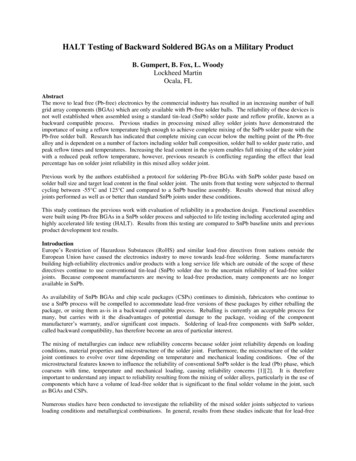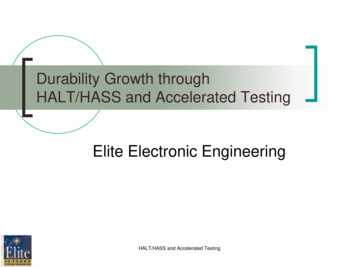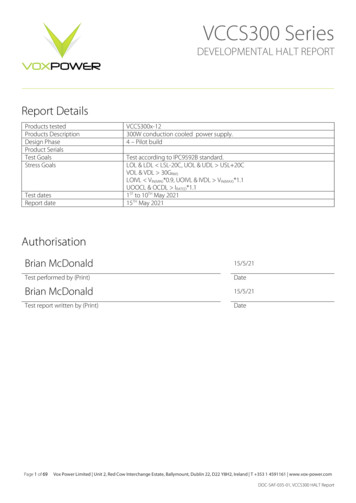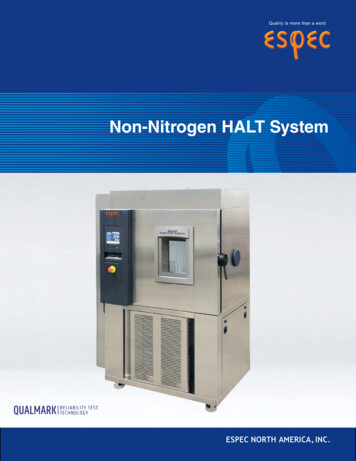
Transcription
HALT Testing of Backward Soldered BGAs on a Military ProductB. Gumpert, B. Fox, L. WoodyLockheed MartinOcala, FLAbstractThe move to lead free (Pb-free) electronics by the commercial industry has resulted in an increasing number of ballgrid array components (BGAs) which are only available with Pb-free solder balls. The reliability of these devices isnot well established when assembled using a standard tin-lead (SnPb) solder paste and reflow profile, known as abackward compatible process. Previous studies in processing mixed alloy solder joints have demonstrated theimportance of using a reflow temperature high enough to achieve complete mixing of the SnPb solder paste with thePb-free solder ball. Research has indicated that complete mixing can occur below the melting point of the Pb-freealloy and is dependent on a number of factors including solder ball composition, solder ball to solder paste ratio, andpeak reflow times and temperatures. Increasing the lead content in the system enables full mixing of the solder jointwith a reduced peak reflow temperature, however, previous research is conflicting regarding the effect that leadpercentage has on solder joint reliability in this mixed alloy solder joint.Previous work by the authors established a protocol for soldering Pb-free BGAs with SnPb solder paste based onsolder ball size and target lead content in the final solder joint. The units from that testing were subjected to thermalcycling between -55 C and 125 C and compared to a SnPb baseline assembly. Results showed that mixed alloyjoints performed as well as or better than standard SnPb joints under these conditions.This study continues the previous work with evaluation of reliability in a production design. Functional assemblieswere built using Pb-free BGAs in a SnPb solder process and subjected to life testing including accelerated aging andhighly accelerated life testing (HALT). Results from this testing are compared to SnPb baseline units and previousproduct development test results.IntroductionEurope’s Restriction of Hazardous Substances (RoHS) and similar lead-free directives from nations outside theEuropean Union have caused the electronics industry to move towards lead-free soldering. Some manufacturersbuilding high-reliability electronics and/or products with a long service life which are outside of the scope of thesedirectives continue to use conventional tin-lead (SnPb) solder due to the uncertain reliability of lead-free solderjoints. Because component manufacturers are moving to lead-free production, many components are no longeravailable in SnPb.As availability of SnPb BGAs and chip scale packages (CSPs) continues to diminish, fabricators who continue touse a SnPb process will be compelled to accommodate lead-free versions of these packages by either reballing thepackage, or using them as-is in a backward compatible process. Reballing is currently an acceptable process formany, but carries with it the disadvantages of potential damage to the package, voiding of the componentmanufacturer’s warranty, and/or significant cost impacts. Soldering of lead-free components with SnPb solder,called backward compatibility, has therefore become an area of particular interest.The mixing of metallurgies can induce new reliability concerns because solder joint reliability depends on loadingconditions, material properties and microstructure of the solder joint. Furthermore, the microstructure of the solderjoint continues to evolve over time depending on temperature and mechanical loading conditions. One of themicrostructural features known to influence the reliability of conventional SnPb solder is the lead (Pb) phase, whichcoarsens with time, temperature and mechanical loading, causing reliability concerns [1][2]. It is thereforeimportant to understand any impact to reliability resulting from the mixing of solder alloys, particularly in the use ofcomponents which have a volume of lead-free solder that is significant to the final solder volume in the joint, suchas BGAs and CSPs.Numerous studies have been conducted to investigate the reliability of the mixed solder joints subjected to variousloading conditions and metallurgical combinations. In general, results from these studies indicate that for lead-free
BGA components assembled with lead-based solder, the reliability is equivalent to completely lead-free assemblies,provided that the Pb is distributed evenly throughout the joint [3-9]. Correspondingly, several studies found that thereliability of solder interconnections degraded when a SAC solder ball is only partially mixed with SnPb solderpaste [4][6][10].The degree of mixing in backward compatibility assembly is expected to be a function of the reflow peaktemperature, time above liquidus (183 C), the alloys used (ball and paste), and the mix ratio of thosealloys[3][7][11-18]. In previous studies, the authors developed processing guidelines for lead-free BGAs and CSPswith SnPb solder paste based on lead content, reflow peak temperature, and time above liquidus (TAL)[19]. Theresult was the chart shown in Figure 1, which is used by the assembler to ensure that full alloy mixing in the BGAsolder joint is achieved, thus providing a reliable joint, while allowing the assembler to adjust the desired parametersof their process to optimize for design-specific restrictions.Figure 1 - Pb content (% wt.) curves for predicting full mixing ofbackward compatible solder joints based on TP and TAL (183 C)In this study, the guidelines developed in that previous work were used to fabricate hardware of an existingproduction design where the SnPb-balled BGAs are replaced with components which have SAC305 balls. Thishardware was then be subjected to HALT and accelerated aging in a fashion similar to the tests used to validateother design changes, to demonstrate the reliability of the Pb-free components used in the backward compatibleprocess.Experimental ProcedureThe test vehicle chosen for this study was a 9” x 5”, two-sided, multi-layer surface mount (predominantly) circuitcard with a variety of component package types (see Figure 2). Three of these components are BGA packages withthe properties shown in Table 1.
BGA 2BGA 3BGA 1Figure 2 – Circuit card test vehicle top side layoutFigure 3 – BGAs used on test vehicleTable 1 – BGA component propertiesBGA#Length(mm)Width(mm)BallCountBall .6Full1335356800.6Island1The existing design includes SnPb balls on the BGA components, so the Pb-free versions on these components wereprocured from the manufacturer and inserted into the assembly. The Pb-free version of each component hasSAC305 balls.
For each BGA, the size of the ball and the existing stencil design was evaluated to determine the expected Pbcontent that would be present in the final joint, assuming full mixing in the joint (see Table 2). Using the currentstencil design, the Pb content in the joints was expected to be quite low. Because there are some component typesused in SMT assembly which have temperature sensitivities beginning around 230-235 C, it was desirable to keepthe reflow profile below 230 C. To stay above the appropriate curves for these Pb levels in Figure 1, a long reflowprofile or a tight process window would be required. In order to enlarge this process window, the stencil apertureswere enlarged to increase the volume of solder paste applied and therefore increase the expected Pb content in thefinal joint.Table 2 – Pb content, with and without stencil design modificationsBGA #Initial StencilAperture (mm)ApertureTypeExpectedPb%Updated StencilAperture (mm)New .647.4%30.48Square5.2%0.647.4%Figure 4 – Initial expected Pb curve levels applied to process chart (left) and updated Pb curve levels appliedto process chart (right). Actual thermocouple values are plotted on the updated chart.After SMT assembly, the required plated through hole components were installed, followed by application ofconformal coating (Type UR). Inspection was performed throughout the process to ensure that the hardware met allquality requirements.On completion of assembly, the test vehicles were divided into two groups; three assemblies were subjected tothermal and vibratory extremes, commonly referred to as Highly Accelerated Life Testing (HALT). The remainingsix units were subjected to accelerated aging through humidity and thermal exposure, along with another four unitsbuilt in a standard production process with SnPb-balled BGAs.HALT:The three units for HALT were exposed to the combined thermal and vibratory environment. The profile consistedof thermal cycling from -67 C to 106 C at a rate of 25 C/min, with 10 minute dwells once the BGA componentsreached temperature. Vibration input was escalated with each thermal cycle. The expected vibration input levelswere to be at least 6 Grms at the holding fixture at the maximum level. Actual vibration responses of the BGAlocations were determined during the process, and functional testing was performed periodically.
Accelerated aging:To induce electronic failures that could be exhibited in the lifetime of fielded hardware, the test units were exposedto increased temperature and humidity levels. An estimate of the amount of life acceleration that this environmentinduced was calculated using a variation of the Arrhenius equation with a humidity stressor applied. This equationis the Hallberg-Peck Model:AF (RHT / RHA) 3 * exp{(Ea/k)*(1/TT-1/TA)}Given:RHTRelative humidity in the test environmentRHARelative humidity in the application environmentEaActivation energykBoltzmann’s constant (k 8.617 x 10-5 eV/Tk)TTTemperature in Kelvin in the test environmentTATemperature in Kelvin in the application environmentA conservative value of 0.7 was chosen for Activation Energy. For this study, a relative humidity of 60% andtemperature of 30 C was assumed for the application environment. The above formula for test acceleration factorcompleted for these values is shown below. Table 3 shows other Acceleration Factors for determining simulated lifebased on a range of application conditions.AF (0.85/0.60)3 * exp{(0.7/8.617E-5)*(1/358-1/303)}AF 2.8 * 61.5 174.8The goal of this study was to fully evaluate the performance of the mixed alloy solder joint over an extended life. Inmany aerospace and defense products, this life can be more than 20 years, even 30 years or more. This aging testwas conducted for 63 days to simulate 30 years of aging.Test time unit:1 dayAcceleration Factor:174.8Simulated Life per day: 174.8/365 0.48 years/dayTotal test time:63 daysTotal Simulated Life:30 yearsTable 3 – Acceleration factors for various expected service life conditions and the given test conditions.Expected RH in Application EnvironmentExpected temperature (K) in Application 6.117.411.70.90129.381.251.833.522.014.69.8
Table 4 – Simulated years of life for various expected service life conditions and the given test conditions anddurationExpected RH in Application EnvironmentExpected temperature ( C) in Application 14.08.95.83.82.51.7The second environment used in the aging sequence was periodic instances of 50 temperature cycles. The profileconsisted of temperature swings from -43 C to 85 C, with a ramp rate of approximately 2.7 C per minute, and with15 minute dwells at each extreme, for a time of approximately 1 hour per cycle.Utilizing the Coffin-Manson equation, these thermal cycles are equivalent to approximately 0.25 years of aging foreach 50 cycle period. This equation is the following:AF (ΔTL / ΔTF)1.9 * (FF / FL )1/3 * exp{Ea/K (1/TmaxF – 1/TmaxL)}Given:ΔTLLab temperature difference between highest and lowest operating temperatureΔTFField temperature difference between on and off stateFFCycle frequency in the field (cycles per 24 hours), minimum number of sixFLCycle frequency in the labTmaxF Max temperature in Kelvin in the application environmentTmaxL Max temperature in Kelvin in the lab environmentThis thermal cycling does not add a significant amount of simulated life time to the test; its main purpose is toexpose the hardware to the thermal cycles that could be experienced over the life cycle in an attempt to causefailures in solder joints that may have been weakened through the aging process.ResultsAll units built were built using standard production processes with in-process checks; inspection, x-ray evaluationand functional test. No issues were identified through these processes. Cross-sections were made of one unit for anevaluation of the as-built condition and verification of full solder joint mixing in the BGA solder joints. Thesecross-sections are shown in Figure 5. The Pb content of the joints was measured through SEM/EDX and found to be6.4%, 7.4%, and 7.4% by weight for BGAs 1, 2, and 3, respectively. As seen in the images, mixing of the alloys inthe solder joint is good, with Pb-rich areas uniformly distributed through the ball. As expected, the Pb-rich areas arenot as dense as they would be in a standard Sn63Pb37 solder joint, and they have a stringy appearance.
Figure 5 – Micrographs of cross-sections for BGAs 1, 2, and 3 in as-built condition.The three assemblies subjected to HALT were built into a representation of a higher level assembly and mounted inthe HALT chamber as shown in Figure 6. A vibration survey was performed on each unit to determine the vibrationresponse at the BGA sites. At the lowest vibration input, the BGAs experience about 5 Grms, and they sawprogressive increases in response as the input was increased, with maximum values of 20, 22, and 27 Grmsexperienced at the three BGA sites.The assembly was exposed to the combined thermal and vibration profile as shown in Figure 7. A thermocouplelocated on top of one of the BGAs (the green line in Figure 7) demonstrated good temperature tracking and was usedto ensure that the desired dwell period was reached. At the completion of the fourth thermal cycle, two of the threeunits were subjected to the addition period of vibration shown, at the maximum level for 60 minutes. The entire testlasted for a little over three hours. Units were tested functionally at the end of each dwell period, and during eachtransition. Units were also tested approximately every ten minutes during extended vibration. All tests were passedsuccessfully.Figure 6 – Unit assembled into test fixture and mounted in the HALT chamber.
Figure 7 – Combined thermal and vibratory profile for units in HALT, with extended vibe. The yellow lineshows vibration input levels at the table, the grey line is the thermal program, and the green line is thethermal reading on one of the BGAs.One of the test units was cross-sectioned after HALT to examine the condition of the BGA solder joints. Although astandard Sn63Pb37 test unit was not exposed to HALT, there was another circuit card in the HALT setup whichincluded such a BGA. This unit was also exposed to the thermal and vibratory conditions, and was cross-sectionedas a comparison. The cross-sections of these post-HALT units are shown in Figure 8. There is no significantchange to the solder joints from the as-built conditions. Although the surfaces of these low-Pb solder joints arerough compared to the Sn63Pb37 joint, this roughness has not increased from the as-built condition. Similarly, theSn63Pb37 solder joint has not changed significantly from the condition typically seen in an as-built joint; the grainstructure is fine and there is no evidence of damage to the joint.ABCDFigure 8 - Micrographs of cross-sections for BGAs 1 (A), 2 (B), 3 (C), and Sn63Pb37 (D) after HALT.
Temperature( C)Figure 9 – Thermal cycling profile for accelerated aging test units.Six test units and four control units (standard SnPb) were subjected to multiple sessions of accelerated aging andthermal cycling. Electrical acceptance testing was performed between these sessions to verify functionality. In all,the test units were exposed to 63 days temperature / humidity (85 C / 85% RH) and 200 thermal cycles (See Figure9) for simulation of approximately 30 years relative to a 60%RH/30 C application environment. The overall flowfor this process is shown in Figure 10.Figure 10 – Accelerated aging process flowAll ten test units successfully passed testing until the final round of aging. In the final test, two of the six mixedalloy units failed a test, indicating a problem with BGA 1. One of the mixed-alloy units subjected to acceleratedaging was cross-sectioned, as well as one of the Sn63Pb37 units, to evaluate the resulting condition of the solderjoints (see Figure 11). The cross sectional images of the post-aging units do not show any significant anomalies inthe solder joints; there were no fractured solder joints, no crack initiation sites, and generally no apparentdeterioration of the solder joints. The mixed-alloy joints still display a uniform distribution of Pb-rich areas ofrelatively fine grain structure. In the post-aging image for the standard SnPb joint, however, there is a significantamount of grain growth. The grain structure of the joint is not as fine as in the as-built condition. Dye-and-pry was
used to evaluate the failed units, and there was no indication of solder joint failure from this inspection; the printedcircuit board pad was partially or fully lifted at all joints as a result of the component removal.ABCDFigure 11 - Micrographs of cross-sections for BGAs 1 (A), 2 (B), 3 (C), and Sn63Pb37 (D) after acceleratedaging.ConclusionsBGAs with SAC305 balls were inserted into an existing military design and installed using a backward compatibleprocess (SnPb solder). The assembly process was modified slightly (solder paste application and reflow profile)according to guidelines developed in previous studies to accommodate these Pb-free components, but kept within awindow suitable for typical SnPb assembly. Cross-section evaluations of the base-line units validate that the processused resulted in complete mixing of the solder joints.These assemblies were subjected to HALT and accelerated aging environments similar to those used in productiondevelopment evaluations. The units survived nearly all functional testing through these environments,demonstrating survivability of the mixed alloy solder joints under exposure to humidity, temperature, vibration, andthermal cycling. The only failures exhibited came after a significant amount of aging and testing was complete, andwere attributed to component failure, not solder joint failure.This study shows that when the parameters of a backward compatible process are appropriately controlled andapplied, the resulting BGA solder joint can have acceptable reliability in a military product for certain expectedenvironmental conditions. We must keep in mind, however, that this relies on certain assumptions about thebehavior of a low-Pb solder joint. Testing of Pb-free solder has demonstrated that reliability can be dependent on theparameters of the test and the order of certain testing. More studies should be performed to further investigate thepoint or range at which the Pb-content of a solder joint results in Pb-free-like behavior or standard SnPb-likebehavior.
One observation of unique interest in this study is the lack of change in the morphology of the mixed-alloy solderjoints. The Sn63Pb37 solder joints show a marked change in structure, with significant grain growth through boththermal cycling and accelerated aging in temperature and humidity. The mixed-allow joints do not show the sameamount of change in shape of the lead-rich areas.Bibliography:[1] A. Dasgupta, P. Sharma, and K. Upadhyayula, “Micro-mechanics of fatigue damage in Pb–Sn solder due tovibration and thermal cycling,” Int. J. Damage Mech., vol. 10, no. 2, April 2001, pp. 101–132.[2] C. Basaran and Y. Wen, “Grain growth in eutectic Pb/Sn ball grid array solder joints,” Proc. Inter Society Conf.Thermal Phenomena, 2002, pp. 903–908.[3] Snugovsky, P., Zbrzezny, A.R., Kelly, M. and Romansky, M., “Theory and practice of lead-free BGA assemblyusing Sn-Pb solder”, CMAP International Conference on Lead-free Soldering, Toronto, Canada, 2005.[4] F. Hua, R. Aspandiar, T. Rothman, C. Anderson, G. Clemons, and M. Klier, “Solder joint reliability of SnAgCuBGA components attached with eutectic SnPb solder paste,” J. Surf. Mount Technol. Assoc., vol. 16, no. 1, 2003,pp. 34–42.[5] Sun, F., “Solder joint reliability of Sn-Ag-Cu BGA and Sn-Pb solder paste”, Proceedings of 2005 IEEE 6thInternational Conference on Electronic Packaging Technology, Shenzhen, China, 2005.[6] D. Hillman, M. Wells, and K. Cho, “The impact of reflowing a leadfree solder alloy using a SnPb solder alloyreflow profile on solder joint integrity,” Proc. Int. Conf. Lead-free Soldering, Toronto, ON, Canada, May 2005.[7] G. Grossmann, J. Tharian, P. Jud, and U. Sennhauser, “Microstructural investigation of lead-free BGAs solderedwith tin–lead solder,” Soldering & Surface Mount Technology, vol. 17, no. 2, Feb. 2005, pp. 10–21.[8] H. McCormick, P. Snugovsky, Z. Bagheri, S. Bagheri, C. Hamilton, G. Riccitelli, and R. Mohabir, “Mixingmetallurgy: Reliability of SAC balled area array packages assembled using SnPb solder,” J. Surf. Mount Technol.Assoc., vol. 20, no. 2, 2007, pp. 11–18.[9] D. Nelson, H. Pallavicini, Q. Zhang, P. Friesen, and A. Dasgupta, “Manufacturing and reliability of lead-free andmixed system assemblies (Snpb/lead-free) in avionics,” J. Surf. Mount Technol. Assoc., vol. 17, no. 1, 2004, pp. 17–24.[10] Gregorich, T. and Holmes, P., “Low-temperature, high reliability assembly of of lead-free CSPS”, IPC/JEDEC4th International Conference on Lead-free Electronic Components and Assemblies, Frankfurt, Germany, 2003.[11] Zbrzezny, A.R., Snugovsky, P., Lindsay, T. and Lau, R., “Reliabilty investigation of Sn-Ag-Cu BGA memorymodules assembled with Sn-Pb eutectic paste during different reflow profiles”, CMAP International Conference onLead-free Soldering, Toronto, Canada, 2005.[12] Zbrzezny, A.R., Snugovsky, P., Lindsay, T. and Lau, R., “Reliabilty investigation of mixed BGA assemblies”,IEEE Transactions on Electronics Packaging Manufacturing, 29 (3), 2006, pp. 211-216.[13] Handwerker, C., “Transitioning to lead free assemblies”, Printed Circuit Design and Manufacturing, March2005.[14] Pan, J., “Estimation of liquidus temperature when SnAgCU BGA/CSP components are soldered with SnPbpaste”, Proceedings of 2006 IEEE 2006 7th International Conference on Electronics Packaging Technology,Shanghai, China, 2006.[15] Shea, C., Pandher, R., Hubbard, K., Ramakrishna, G., Syed, A., Henshall, G., Chu, Q., Tokotch, N., Escuro, L.,Lapitan, M., Ta, G., Babasa, A., Wable, G., “Low-silver BGA assembly phase I – reflow considerations and jointhomogeneity initial report”, Proceedings of 2008 IPC APEX Conference, Las Vegas, NV, 2008.[16] Shea, C., Pandher, R., Hubbard, K., Ramakrishna, G., Syed, A., Henshall, G., Chu, Q., Tokotch, N., Escuro, L.,Lapitan, M., Ta, G., Babasa, A., Wable, G., “Low-silver BGA assembly phase I – reflow considerations and jointhomogeneity second report: SAC105 spheres with tin-lead paste”, Proceedings of 2008 SMTA International,Orlando, FL, 2008.[17] Shea, C., Pandher, R., Hubbard, K., Ramakrishna, G., Syed, A., Henshall, G., Chu, Q., Doxtad, E., Santos, M.,Lapitan, M., Solon, J., Babasa, A., Wable, G., “Low-silver BGA assembly phase II – reflow considerations and jointhomogeneity third report: comparison of four low-silver sphere alloys and assembly process sensitivities”,Proceedings of 2009 IPC APEX Conference, Las Vegas, NV, 2009.[18] Shea, C., Pandher, R., Hubbard, K., Ramakrishna, G., Syed, A., Henshall, Fehrenbach, M., G., Chu, Q., Wable,G., “Low-silver BGA assembly phase II – reflow considerations and joint homogeneity fourth report: sensitivity toprocess variations”, Proceedings of 2009 SMTA International, San Diego, CA, 2009.[19] B. Fox, B. Gumpert, L. Woody, “Development of Processing Parameters for Soldering Lead-Free Ball GridArrays Using Tin-Lead Solder”, Proceedings of 2009 SMTA International, Orlando, FL, 2012
HALT Testing of Backward SolderedBGAs on a Military ProductBen GumpertLockheed Martin352-687-5952 ben.gumpert@lmco.com 2012 Lockheed Martin
Outline/Agenda Introduction– History / previous studies– Prediction Experiments and Results– HALT– Accelerated Aging– Conclusions Q&A
Past Work Review:Backward compatibility Complete mixing of materials key for survival of solder joints Dependent on reflow parameters (TAL, TP) Alloys and mix ratio also important
Acceptable Solder Joint Prediction Dashed box representsrange of data fromprior testing Reflow needs to beabove the appropriatecurve for fully mixedjoint
Thermal Cycling Results
Test Vehicle Variety of package typesThree different BGA typesDouble-sided, 16-layer SMTBGA 2BGA 3BGA 1
Pb ContentInitialUpdatedBGA Stencil Ap. Aperture Expected Stencil#(mm)TypePb%Ap. 4%7.4%7.4%
Testing HALT– Three mixed-alloy solder units Accelerated Aging– Six mixed-alloy solder units– Four Sn63Pb37 baseline units
Thermal cyclesHALT Profile– -67 C to 106 C, 25 C / minute ramp Vibration– Increasing input, from 5 up to 20 Grms response– Extended vibration duration at high level
HALT Chamber
HALT Results No failures throughout testing No significant impact to solder jointPre-HALTPost-HALT
HALT Results Sn63Pb37 control (Post-HALT)
Accelerated Aging Aging induced by thermal and humidity exposure Periodic thermal cycling to induce stresses Periodic functional test
Accelerated AgingHallberg-Peck Model:Given:– RHT Relative humidity in the test environment– RHA Relative humidity in the application environment– Ea Activation energy– k Boltzmann’s constant (k 8.617 x 10-5 eV/Tk)– Tt Temperature in Kelvin in the test environment– Ta Temperature in Kelvin in the application environment
Accelerated AgingResultingAcceleration Factor:Expected Temperature ( C) in Application EnvironmentExpected RH2030354045500.30 3492.12193.11398.6905.1593.9394.9265.90.40 ed temperature ( C) in Application EnvironmentExpected RHSimulated yearsfrom 63 9.512.88.55.70.7047.429.819.012.38.15.43.6
Accelerated Aging – Thermal 1211221231241251261271281291-43 C to 85 C15 minute dwells50 cycle sessions4 sessions total throughtestingTemperature ( C 100.00Time (minutes)
Accelerated Aging Results No test failures through the first 56 days agingand 150 thermal cycles Two failures at final round of functional test– Both failures were at BGA 1 on mixed-alloy units– Attributed to component failure Representative solder jointslook good in cross-section Dye and pry does not indicatejoint fracture, all pads lifted atboard
Accelerated Aging Results Grain growth apparent in solder joints of Sn63Pb37 unitsPre-AgingPost-Aging
Accelerated Aging Results No significant change to solder joint in mixed-alloy unitsPre-AgingPost-Aging
Conclusions PROCESS:Successfully demonstrated the process developed forbackward compatibility Reliability:Showed survivability of mixed-alloy joints in HALT andAccelerated Aging environments that woulddemonstrate acceptance for military product
Thoughts for discussion Do low-Pb joints act like Sn63Pb37 joints?– Where is the tipping point? What does the lack of apparent change inmorphology of the low-Pb solder joint tell us?
Questions?Thank you!
built in a standard production process with SnPb-balled BGAs. HALT: The three units for HALT were exposed to the combined thermal and vibratory environment. The profile consisted of thermal cycling from -67 C to 106 C at a rate of 25 C/min, with 10 minute dwells once the BGA components reached temperature.










